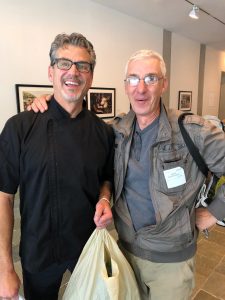
I’ll have (a lot) more to say about this program as the time nears, but here’s a heads up: On April 8 at 8 p.m. I’ll be leading a discussion on “The Foraged Seder” with master forager Pascal Bauder at the Skirball Cultural Center.
Bauder spends his days exploring the seasonal, wild edible foods of Los Angeles, and Ive been spending mine thinking about the connection between food, spirituality and nature. Our two passions come together on the seder plate, where a few seasonal foods symbolize our connections to history, God and the natural world.
During and after our discussion, you will get a chance to taste (small tastes, the Skirball people want me to remind you) the food Pascal has foraged and Passover dishes that Skirball Chef Sean Sheridan has created from those foods. (I’m pretty excited about the prospect of a manzanita apple and elderberry wine haroset.)

Chef Sean Sheridan (l) and forager Pascal Bauder at the Skirball Cultural Center (Photo by Rob Eshman)
Three years ago I took part in one of Pascal’s foraging classes in the San Gabriel mountains. As we walked he plucked the leaves of plants and trees I’d hiked past a thousand times, explained their edible uses, and handed them to us.
“We can eat this?”
“Yes, you can eat that.”
Amazing. When the Skirball asked me if I would be interested in designing a Passover food program, I immediately thought of that experience. Passover marks the deliverance of the Children of Israel from Egyptian bondage. It is a celebration of liberation, freedom and rebirth. It recalls a moment in our story when we escaped civilization for the wilderness, and the wilderness saved us. I thought: What would happen if we used real wild food to tell that story? Would we connect to it in a deeper way? Would we understand it differently?
Spoiler alert: I’m pretty sure the answer is yes.
OK, enough of a tease. We’ll talk more later. You can sign up here.